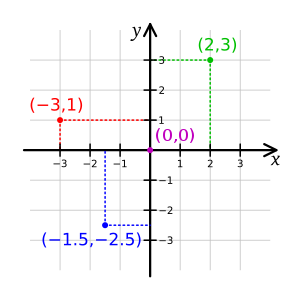Physics Explained Through a Video Game/Displacement
Introduction
editDisplacement is the change of an object's position between two times. It is a vector quantity, meaning that it has both a direction and a magnitude.[1]
Direction of Displacement
editDisplacement's direction is dependent on our choice of what is the positive direction and the negative direction are. This choice can vary between situations. However, we tend to consider the Cartesian grid convention to figure out whether a displacement is positive or negative.

To the right is an image of a 2D-Cartesian grid. We generally use the convention that an upwards motion (+Y direction) has a positive vertical displacement and a rightwards motion (+X direction) has a positive horizontal displacement.
With this in mind, if an object is found to have a motion in a certain direction, we can decide if it has a negative or positive displacement, as listed in the table below.
| Relative Direction of Motion of an Object | Displacement Type |
|---|---|
| Upwards (↑) | (+) Vertically Positive |
| Downwards (↓) | (-) Vertically Negative |
| Rightwards (→) | (+) Horizontally Positive |
| Leftwards (←) | (-) Horizontally Negative |
| Any combination of horizontal and vertical directions (eg. ↖, ↗, and ↘) | To be discussed in the following topic. |
Displacement with the Cartesian Grid Convention
edit
As a general example, consider a handful of balloons above that are rising relative to the ground in Balloon Fight by MuadDib. These balloons are above the ground and becoming farther from it, traveling in an upwards motion. Therefore, we can use the Cartesian grid convention to show that the balloons are having a positive vertical displacement relative to the ground.
Exceptions to the Cartesian Grid Convention
edit|
The car in Cruisin' 4A Bruisin' by Raspy 667 is facing and moving leftwards. To note, it's typical for cars to move in the way in which they are facing. Therefore, if we were to track the motion of this car on the bridge above, it may be more practical to assume that when the car moves forewords (in the leftward direction in this case) that it is moving in the positive direction. As such, we may want to define the leftward motion of the car to instead result in a positive displacement, overruling the Cartesian grid convention. |
In contrast, if the car was moving backwards (in that it was reversing), we could define the rightward direction of movement to result in a negative displacement. Because cars don't reverse as often as drive forwards, it's more convenient to have the negative direction be for when the car reverses.
|
Magnitude of Displacement
edit
The magnitude of displacement is dependent on the shortest distance that exists between the starting and ending point during the observation of an object. Thus, the path taken between the start and end points doesn't effect the displacement. Instead, only the location of the start and end points do.[3]
As an example, suppose you are playing Battlegrounds 2 by HeyListen (on the right) and your goal is to cross to the other green hill. You can either jump up onto the ladder to cross or dodge cannon balls to get across. Assuming that you have the same start and end points, you will have the same displacement in either case.
As such, although there are paths of different lengths between Point A and Point B in the image, the displacement magnitude remains the same.
- ↑ “8.2: Kinematics.” Physics LibreTexts, 10 Nov. 2021, https://phys.libretexts.org/Courses/University_of_California_Davis/UCD%3A_Physics_7B_-_General_Physics/8%3A_Force_and_Motion/8.2%3A_Kinematics.
- ↑ Kbolino, Public domain, via Wikimedia Commons
- ↑ Urone, Paul Peter, and Roger Hinrichs. 2.1 Displacement - College Physics | OpenStax. 21 June 2012, https://openstax.org/books/college-physics-2e/pages/2-1-displacement.